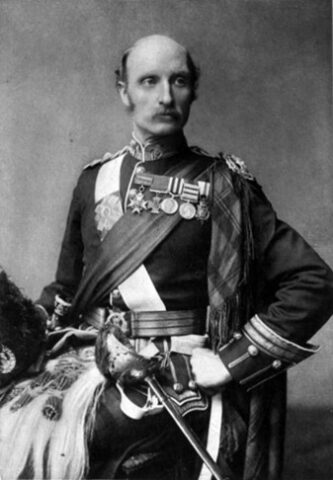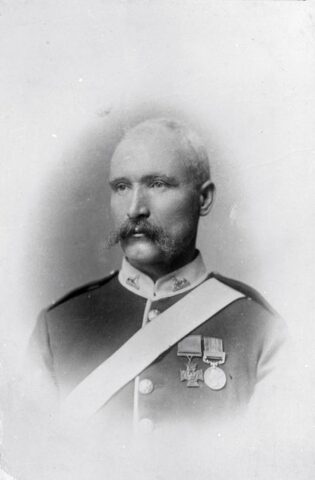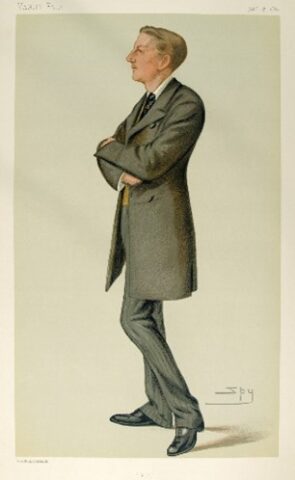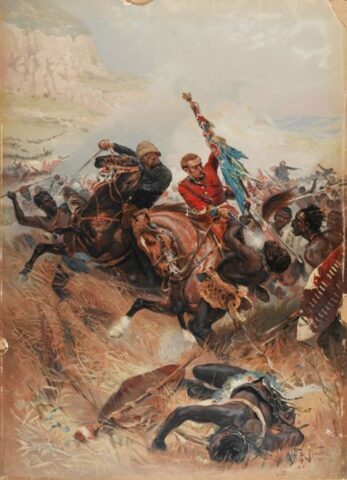Gibraltar and the Victoria Cross
Kavanagh’s grave at North Front cemetery
By Lt Col (retd) Francis Brancato, Chairman of the Gibraltar Branch of the Royal British Legion
The recent visit to Gibraltar of Warrant Officer Johnson Beharry, recipient of the Victoria Cross (VC), provides the perfect opportunity to re-discover the long and close association between the Rock and those who have been awarded the highest accolade for bravery that can be bestowed by Britain and the Commonwealth.
Gibraltar born and Gibraltar buried
Born in Gibraltar on 20 September 1875, where his father was stationed at the time, Wallace Wright was commissioned into the Queens Royal Regiment (West Surrey) in 1896. He served on the North-West Frontier during which time he was severely wounded. In 1901, Wright was sent to Nigeria where he was attached to the North Nigeria Regiment during the Kano-Sokoto Expedition. On 26 February 1903 in Nigeria:
“Lieutenant Wright, with only 44 men took up a position in the path of the advancing enemy sustained the determined charges of 1,000 Horse and 2,000 Foot for two hours and when the enemy, after heavy losses, fell back in good order, Lieutenant Wright continued to follow them up until they were in full retreat”.
 Brigadier Wallace Wright VC
Brigadier Wallace Wright VC
Awarded the VC for this action, Wright went on to serve in both WW1 and WW2 reaching the rank of Brigadier. He was MP for Tavistock from 1928 until 1931.
Thomas Henry Kavanagh was one of the most celebrated VCs of the Indian Mutiny. He also caught the British public’s imagination as one of the only five (to date) civilian VCs. He was awarded the medal for his gallantry during the siege of Lucknow. Kavanagh volunteered to slip through enemy lines and guide the approaching column of Sir Colin Campbell towards the British compound at Lucknow. Dressed as an Indian and with his face blackened, he left the Residency at Lucknow and after many adventures he found and guided the British column.
 Thomas Kavanagh VC
Thomas Kavanagh VC
In 1882, at the invitation of the then Governor of Gibraltar, his old friend from Lucknow General Napier, he sailed here but was taken ill on the voyage. On arrival, he was immediately taken to hospital, where he died on 11th November. In demonstration of the esteem in which he was held, he was given a full military funeral, and his coffin was taken to North Front Cemetery by 200 men of the Loyal North Lancashire Regiment. Kavanagh is buried at North Front Cemetery
The Governors
Gibraltar has had two Governors holders of the VC – Field Marshal Sir George Stuart White (May 1900-August 1905) and Field Marshal The Hon John Vereker, 6th Viscount Gort (May 1941-May 1942).
White was stationed at Peshawar with the 27th Inniskilling Regiment during the Indian Mutiny and then fought at the Battle of Charasiab in October 1879 and at the Battle of Kandahar in September 1880 during the Second Afghan War. For his bravery during these two battles, where he personally led frontal charges against heavily fortified positions, he was awarded the VC.
White went on to command The Gordon Highlanders and served in India, Burma and the Sudan. In 1893 he was promoted to Lt Gen and appointed Commander in Chief of India. During the Boer War, he commanded the garrison at Ladysmith, which he held until relieved.
 Field Marshal Sir George Stuart White VC
Field Marshal Sir George Stuart White VC
White became Governor of Gibraltar in May 1900 and, in that role, was promoted to full General on 9 October 1900 and to Field Marshal on 8 April 1903. His son, Captain James (Jack) White became his ADC in Gibraltar and later married local beauty Anna Mercedes Dolores (‘Dollie’) Mosley, daughter of local magnate Sir Alexander Mosley.
 Field Marshal Viscount Gort VC
Field Marshal Viscount Gort VC
Viscount Gort was awarded the VC for most conspicuous bravery, skilful leading and devotion to duty during the attack of the Guards Division on 27th September 1918, across the Canal du Nord, near Flesquieres, when in command of the 1st Battalion, Grenadier Guards.
“Tiger” Gort as he became known also won two Distinguish Service Orders (DSOs) and a Military Cross (MC) during his long and distinguished military career, attaining the post of Chief of the Imperial General staff (the professional head of the British Army). He is also well known for commanding the British Expeditionary Force (BEF) that was sent to France in the first year of WW2 only to be evacuated from Dunkirk the following year. From Gibraltar, Gort went out to Malta as Governor and led the valiant defence of the island.
VC presented in Gibraltar
Five VCs have been presented in Gibraltar. The first three occurred very soon after the first investiture of the Victoria Cross, made in person by Queen Victoria in June 1857. At the same time as recipients in England were being decorated, instructions were sent to commanders of the overseas stations, instructing them to confer the award on the recipients under their command. In Gibraltar, this took place on the 6th August 1857 by the then Governor, Lieutenant General Sir James Fergusson to Major Frederick Elton of 55th Border Regiment; Private Thomas Beach of the same unit and Private Joseph Prosser of the 1st of Foot (Royal Scots) for their actions during the Crimean War.
Private John Williams was presented with his VC by the Governor Major-General Anderson at Grand Parade on 10th April 1880.
 Private John Williams VC
Private John Williams VC
Williams was a 21-year-old private in the 2nd Battalion, 24th Regiment of Foot (later the South Wales Borderers) during the Anglo-Zulu War. On 22–23 January 1879 at Rorke’s Drift, Williams and two other men held a distant room of the hospital for more than an hour until they had no ammunition left, when the Zulus burst in and killed one of the men and two patients. Meanwhile, he succeeded in knocking a hole in the partition and took the two remaining patients through into the next ward. There he was joined by Private Hook and working together (one holding the enemy at bayonet point while the other broke through three more partitions) they were able to bring eight patients into the inner line of defence. Williams’ action and that of his comrades at Rorke’s Drift was immortalised in the epic 1964 film “Zulu”.
 Presentation of the VC to Pte Williams at Grand Parade
Presentation of the VC to Pte Williams at Grand Parade
Incidentally, at the end of the war, the battalion was sent to Gibraltar, which they reached on 12th Feb 1880, with some of the other VC winners present at the parade.
Another VC presented at Grand Parade was that of Major (later Lt Col) Hans Garrett Moore of the 88th Regiment (Connaught Rangers) a year earlier on 6th Sept 1879. Moore had, rather controversially, earned his VC for his action near Komgha, South Africa, during the Cape Wars in 1877 for his valiant attempt in rescuing a wounded trooper from marauding Gaika tribesmen. The controversy arose because Moore had written the citation and recommendation himself. This explains the delay in confirming and presenting the award. Moore had since transferred to the 93rd (Sutherland Highlanders) with whom he was serving in Gibraltar at the time.
The General, the Admiral and the Colonial Secretary
General Sir Frederick Maude was posted to Gibraltar and served as the Garrison’s Adjutant General from 1860-1865. He was awarded the VC for his actions when in command of The Buffs (33rd of Foot) during the Crimean War, where he personally led the covering and ladder party at the final assault on the Redan Forts, where he was severely wounded.
Maude’s youngest son, also called Frederick, was born in Gibraltar on 24 June 1864 and would follow in his father’s footsteps, reaching the rank of Lieutenant General. He is best known for his leadership of the Mesopotamian Campaign during WW1 and for conquering Baghdad in 1917.
Admiral Victor Crutchley joined the Royal Navy in 1906 and at the start of WW1, was a Lieutenant onboard the battleship HMS Centurion during the Battle of Jutland. In 1918 he took part in the 2nd Ostend Raid where he took command of the cruiser Vindictive and scuttled it to close the canal and later successfully oversaw the evacuation of personnel under fire for which he was awarded the VC.
 Admiral Crutchley as Flag Officer Gibraltar
Admiral Crutchley as Flag Officer Gibraltar
Crutchley had a successful Naval career and served in the North Sea and the Pacific in WW2. Crutchley’s final command was as Flag Officer Gibraltar after the war (January 1945 – January 1947) retiring thereafter and promoted to Admiral.
Edric Frederick Gifford, 3rd Baron Gifford was Gibraltar’s Colonial Secretary from 1883 to 1887. In 1874, at the age of 23, Gifford was a young Lieutenant in the 2nd Battalion 24th of Foot (later South Wales Borderers) during the 3rd Ashanti War, where he distinguished himself for his conduct at the taking of Becquah, into which place he penetrated with his scouts before the troops captured it.
Gifford left the Army as a Major and joined the Colonial Civil Service, eventually culminating in his appointment as the Colonial Secretary firstly in Western Australia and later in Gibraltar. During his time here he resided in 24 Turnbull’s Lane.
 Lord Gifford, Colonial Secretary Gibraltar
Lord Gifford, Colonial Secretary Gibraltar
Brothers in Arms
The local masonic lodge, The Royal Lodge of Friendship (No.278 of the English Constitution) has the unique distinction of having four VC holders amongst its brethren. These include Alexander Roberts Dunn, the first Canadian awarded the Victoria Cross, which he earned for his actions during the famous “Charge of the Light Brigade” during the Crimean War, later immortalised in the poem by Lord Tennyson. Dunn was posted to Gibraltar in 1861 and was elected Master of the Lodge, but he declined the appointment as his stay here was uncertain. He was later killed in Abyssinia in 1868.
Another member of the Lodge was Lieutenant Colonel Arthur Pickard who was awarded his VC for his bravery during the invasion of Waikato, during the New Zealand Wars. Pickard, a Royal Artillery officer, was stationed in Gibraltar during the mid-1870s having come out here as the Equerry to HRH Prince Arthur, The Duke of Connaught and Strathearn, who at the time was stationed as part the Garrison Staff. Incidentally, the Prince was also a member of the same Lodge.
Lieutenants Melvill and Coghill had both joined the Lodge in 1874 whilst stationed here with the 24th of Foot. They are perhaps best known for their joint action at Isandlwana on 22nd January 1879 during the Zulu War.
 Lts Goghill & Melvill saving the Colours (NAM Collection)
Lts Goghill & Melvill saving the Colours (NAM Collection)
Tasked with saving the Colours of the battalion, they cut their way out of the surrounding Zulus and reached the Buffalo River. Both lost their horses but managed to swim across the river. The Colour however was swept from their grasp and floated down the bank. Exhausted and eventually surrounded on the far side of the river, they were killed by the Zulus after having exhausted their ammunition. Their bodies were later discovered side by side, and they were buried together where they fell.
I am indebted to local Masonic historian Keith Sheriff for his research on the Royal Lodge of Friendship and its historic connection with the Victoria Cross.









